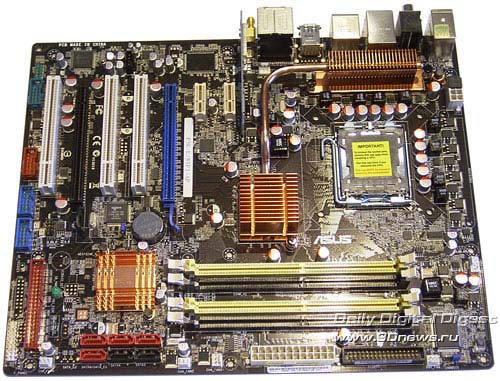Intel P35 Motherboards Roundup Review

Author:
Date: 27.12.2007 |
|
Final Words
Now it's time we settle with the most well-off users who buy only the best and fastest hardware despite the prices. A typical PC configuration for such a user includes two AMD video cards in the Crossfire mode, a 4-core CPU, and DDR3 memory. For these money-bags, motherboards based on P35 are not of interest - they really need the latest models based on the Intel X38 chipset.
Users who prefer the NVIDIA SLI technology will be disappointed: none of Intel chipsets supports the SLI. Technically, there are no hindrances for using the SLI, but NVIDIA is not hasty at including support for this technology into its drivers.
However, if Crossfire and SLI is not needed, then you are our client, so a motherboard based on the P35 chipset is the best choice. Originally, we wanted to exclude all motherboards with support for DDR3 out of the review, because such memory costs incredibly high. However, the price may go down sharply and in that case the buyer needs to know which motherboards should be drawn attention at. In fact, only ASUS presented a wide assortment of motherboards like these and they all fall within the high-end category. Moreover, they don't overlap at their capabilities, i.e. they are not competitors. In particular, ASUS Blitz Extreme is aimed solely at PC enthusiasts and before the release of X38-based products it used to be the best board for such users. At the same time, it is a record-breaker at overclocking and provides a stable operation at FSB = 566 MHz (which is equivalent to 2264 MHz QPB)! Therefore, we reward this motherboard with the "Overclocker's Choice" medal.


Another model - ASUS P5K3 Premium - is entirely different from all the other boards in the two 1 GB DDR3 memory modules soldered into. The manufacturing quality is so high that we reward this board with the "Innovation Design" medal.
As regards ASUS P5K3 Deluxe, it is based on the PCB design of the Premium version, but instead of soldered-in modules it has four DDR3 slots. At the same time, it costs much cheaper than ASUS Blitz Extreme. Therefore, we reward this product with the "Recommended" medal.
But we repeat it again that we recommend motherboards aimed DDR3 modules only if the user can afford to buy DDR3 memory.
We note it separately that all the three boards are able overclocking processors effectively and overcome the 560 MHz bar. Of all the remaining motherboards with support for DDR2, only ASUS Blitz Formula was able to provide a stable operation at such frequency. Therefore, it is also granted with the "Overclocker's Choice" medal.
However, if we analyze the motherboards in terms of the "price/functionality" ratio, we get somehow different findings. We break up the "regular" boards (i.e. with support for DDR2) into the three price categories: $200-250, $150-200, and $100-150, and choose the best of them. We note it separately that ASUS Blitz Formula offers a number of unique features (for motherboards based on P35) and costs about ~$300. But as we already stated, this product has lost its attraction after the release of new ASUS models based on the X38 with the same (and even better) specifications costing ~$320 (we mean the model ASUS Maximus Formula).
In the top-end price category, the situation is not simple at all. It includes the following products: ASUS P5K Premium and ASUS P5K Deluxe (both priced equally: ~$220~230) and Gigabyte P35-DQ6 (~$210-250). You don't have to buy these boards: ASUS P5K-E/WiFi offers the same feature-set, supports all ASUS' modern technologies and costs ~$160! Moreover, ASUS offers a version without the Wi-Fi, but we still don't know how much it will cost and also if the overclocking tools will be cut down (the expansion options, according to ASUS' web site, have remained at the level of the version offering the Wi-Fi functionality).
This motherboard is a competitor to abit IP35 Pro (~$156-190) and MSI P35 Platinum (~$160-180). We should also add Foxconn MARS into this group, although its retail price is still unknown. What to choose? At the expansion options, all the four motherboards are approximately on par. The minor differences are in that abit IP35 Pro offers two Gigabit LAN controllers and eight SATA II links, while ASUS P5K-E/WiFi - one network controller and eight SATA II links. At the same time, the ASUS board has two USB2.0 ports as little, and instead of them there is an onboard Wi-Fi module. The Foxconn and MSI boards have one network controller each and seven SATA II links.
Therefore, if you need the best expansion options, you should stop at abit IP35 Pro
and ASUS P5K-E/WiFi boards (if needed, you can also look at ASUS P5K-E without support for Wi-Fi).
Both the boards have been rewarded with the "Recommended" medal.
Now regarding which model to choose for overclocking. About five years ago, the choice used to be between ASUS and abit (formerly, Abit) boards. While ASUS has gained an indisputable leadership on the market of motherboards so far, abit has lost its grounds. However, it has retained its brand and status of the "tier two leading manufacturer". And, judging by the review, the only representative of the tier two.
So, we recommend to buy the following two boards for overclocking: ASUS P5K-E/WiFi and Foxconn MARS. While it is all clear with the ASUS model,
we were really surprised by Foxconn who has released a simply fantastic motherboard.
The only shortcoming of Foxconn is not a good enough reputation among overclockers. Normally, motherboards by this manufacturer overclock poorly, and the MARS model is just the exception which confirms the rule.
Both the boards have been rewarded with the "Overclocker's Choice" medal!
Now look at the lowest price category, i.e motherboards priced at $100 to $150. It includes ECS P35T-A (~$95-100), Foxconn P35A (~$105-120), MSI P35 Neo Combo (~$115), and MSI P35 Neo (~$100-115). What we'd like to note is that if you are into saving every dime, don't buy the cheapest board. At this amount you can buy a motherboard that is higher in its class but built on the chipset of the previous generation (i.e., Intel P965). If you do need the capabilities of P35, then it makes sense to look at the two motherboards: ECS P35T-A and Foxconn P35A. They offer really good expansion options which include two PCI Express x16 slots. At the same time, the ECS board offers support for seven SerialATA II links, whereas all the other cheap boards - only five links. In view of the lowest price, the ECS P35T-A model is rewarded with the "Best Buy" medal:


However, overclockers will be disappointed by this board since it is unable to operate at even FSB = 400 MHz. But the Foxconn works not only at 400 but at 500 MHz! Therefore, the "Overclocker's Choice" medal has been granted to this product.
the PCB design in many ways has been inherited from the MARS board
|





















